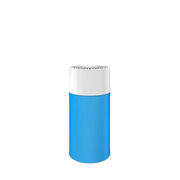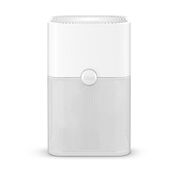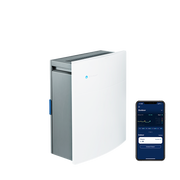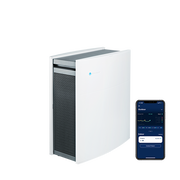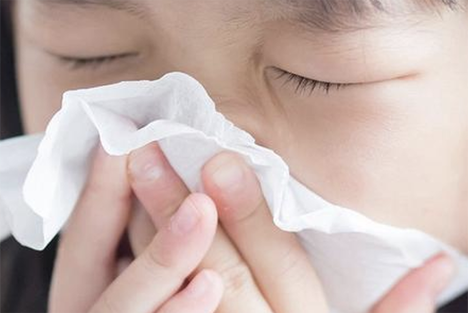
Allergies can be triggered by many sources including, seasonal pollens, indoor ventilation, and environmental conditions in your home, like the presence of pets and dust. With a wide range of sources, allergy symptoms can appear in varying degrees year-round, and using an air purifier to filter out airborne allergens is one way to help manage your allergen exposure indoors.⁰
Fortunately, air purifiers can help manage exposure to airborne allergens.
Designed for the specific purpose of improving indoor air quality, air purifiers remove airborne particles, including those that can trigger allergies like pollen, pet dander, dust and mold. Generally, how it works it simple – the air purifier’s fan pulls in polluted room air, then pushes the air through a filter or layer of filters to capture the particles before releasing clean air back into the room.
Similar to the recommendations from the EPA,¹ we recommend considering a few key factors when selecting an air purifier for allergies; filter type, independent performance certifications, and room size.
Selecting an air purifier filter for allergies
Allergens like dust, pollen, mold, and pet dander fall under the ‘particle’ category of airborne pollutants. Selecting an air purifier with particle filter media, or combination particle and carbon ensures the filter can do its job.
Effective air purifiers with high CADR
Independent evaluations of product performance can help you feel confident that your product will do what it says it will. For air purifiers, consumers can look to the Association of Home Appliance Manufacturer’s AHAM Verified® label and Clean Air Delivery Rate (CADR) to evaluate performance.
CADR indicates the air purifier's ability to reduce airborne particles at three common sizes, each represented by an air pollutant of that size: smoke, dust, and pollen. Look at air purifiers with a high Clean Air Delivery Rate (CADR) - the higher the CADR number, the more effective the air purifier is at removing those pollutants.

All AHAM Verified® air purifiers are given a recommended room size. It is important to choose an air purifier that can accommodate the volume of air in the room where you will place it. This ensures there is enough airflow (measured in air changes per hour or ACH) to reduce allergen levels consistently and over a long period of time. We recommend placing your air purifier in the room(s) where you spend most of your time – often the bedroom. Bedrooms can also have high levels of allergens like pollen, pet dander, dust, and dust mites.
When evaluating an air purifier for allergies, you may also want to consider selecting a model rated for a larger room size. The larger room size increases the number of air changes per hour (ACH), or the number of times all the air in the room gets filtered through the air purifier.
All Blueair purifiers remove airborne allergens
like pollen, dust, pet dander, and mold.

All Blueair purifiers are AHAM Verified® for Clean Air Delivery Rate (CADR) - ensuring the removal of airborne allergens with a combination of a high filtration efficiency via HEPASilent™ technology and adequate airflow for a wide range of room sizes. Additionally, all Blueair models utilize HEPASilent filtration technology, which achieves a filtration efficiency equal to that of True HEPA, while consuming less energy and producing less noise.²
As an allergy sufferer, this means you can select any Blueair model that fits your room size and remove allergens efficiently. For additional features like the ability to remotely control settings and monitor particle levels, consider DustMagnet™, HealthProtect™, or Classic air purifier models ending in 80i. And if you’re interested in additional protection against viruses and bacteria, you may consider a HealthProtect air purifier.

While an air purifier for allergies is useful for managing your exposure to airborne allergens, understanding the sources that trigger symptoms can be helpful to decreasing your overall exposure.
Spring is a beautiful time of year as flowers bloom and landscapes turn green. It’s also a time of year for many when allergies seem to peak. As trees and grasses release tiny grains of pollen into the air, millions of people start to sniffle and sneeze with the symptoms of hay fever (congestion, runny nose, itchy eyes). Pollen from these sources can travel for hundreds of miles,³ so it is not always the plants in your neighborhood that are the issue.
The amount and types of pollen in the air depend on where you live, the time of year, and weather conditions. For example, pollen counts are generally higher on breezy days, and during the spring and summer, tree and grass pollen levels are highest in the evening.

Similar to the spring, fall allergy season is caused by the release of pollen into the air. While spring and summer pollens are produced by trees and grasses, it’s plants like ragweed, and mold that trigger hay fever symptoms in the fall. Ragweed is known as one of the most common environmental allergens and can trigger asthma attacks in addition to hay fever, children and the elderly are most at risk.⁴

Monitoring local pollen counts, especially during peak hours, before you step outside or open the windows can help limit exposure. Peak times usually follow a seasonal pattern and can be avoided - evenings in the spring and summer, and mornings in late summer to early fall.⁵
Pollen sticks to your clothes, hair, and fabrics, meaning you can unintentionally carry it with you throughout the day and spread to unexpected places, like pillowcases.
- Keep windows and doors shut during peak hours
- Remove your shoes and jacket after being outdoors
- Vacuum carpets and upholstery and wash linens and curtains regularly
- Shower to wash pollen out of hair and change clothing before bed
- Bathe pets that spend time outdoors frequently
- Consider an air purifier to reduce airborne pollen from trees, grasses, and weeds.

Exposure to mold is another cause of allergies and is unique in the sense that exposure can come from sources inside your home as well as outdoors. Molds are fungi that often grow indoors in damp areas, such as basements and bathrooms. Outdoors, your garden and yard are great places for mold spores, as they thrive in damp leaves and compost, especially in the fall when leaves begin to decay.
Manage your mold exposure in your home by monitoring humidity levels (ideal range is 35-50% humidity) and limit outdoor exposure in the following ways.
- Use a dehumidifier in the house, especially in the basement if humidity is above 50 percent.
- Clean damp areas like bathrooms and the kitchen regularly, preferably with a non-chemical solution such as vinegar.
- Collect and remove leaves from your yard and gutters to help prevent mold growth.
- Consider wearing a protective mask during yard work.
- Consider an air purifier to reduce airborne mold and mold spores.

Dust mites are thought to be the most common trigger of year-round allergies due to their prevalence in our indoor environments.⁶ Microscopic arthropods, dust mites feed primarily on our shed skin cells found deep in carpets, mattresses, sofas and other textiles in our homes. Reduce dust mite exposure in your home with the following recommendations.
- Before you turn the central heating on for the first time after summer, change HVAC filters as dust and other allergens can get trapped in the vents.
- Use dust-proof allergy covers for mattresses and pillows, and regularly wash bedding in hot water.
- Dust and vacuum your home regularly. Be sure to wear a filtering mask and turn your air purifier up to high while cleaning.
- Consider replacing wall-to-wall carpet with hardwood floors.
- Consider an air purifier to reduce airborne dust and dust mites.

Whether it's from a dog, cat, or other pet, most pet allergies are caused exposure to pet dander and not pet hair. Pet dander is made up of small flecks of skin shed by cats, dogs, rodents, birds and other animals with fur or feathers. Pet-related allergies can also be triggered by proteins found in the pets’ saliva, urine, and feces. If you have a pet in your home, you can limit the allergen exposure in the following ways.
- Keep pets out of the bedroom of the allergy sufferer.
- Train pets to stay away from furniture that can collect dander, like sofas and pillows.
- Limit pets to the areas of your home with non-carpeted flooring if possible.
- Vacuum carpets and furniture regularly and set your air purifier to high while vacuuming.
- Consider an air purifier to reduce airborne pet dander.
All Blueair models are AHAM Verified® for Clean Air Delivery Rate (CADR) to ensure high airflow and filtration efficiency for a wide range of room sizes. If you’re an allergy sufferer, this means you can select any Blueair purifier to efficiently remove allergens like pollen, dust, pet dander, mold spores, and more.
⁰Blueair purifiers do not claim to prevent allergic reactions or allergies.
¹EPA, ‘Guide to Air Cleaners in the Home’, August 2018
²Third-party performance testing of CADR vs select models. Based on tests of HEPASilent technology (mechanical + electrostatic filtration) vs. mechanical filtration alone, producing higher CADR (GB/T 18801-2015), lower noise level (ISO3743), and lower energy consumption in a standalone model.
³Asthma and Allergy Foundation of America, ‘Ragweed Pollen Allergy’
⁴EPA, ‘Ragweed Climate Change Indicators: Ragweed Pollen Season’
⁵American College of Allergy, Asthma & Immunology, ‘Environmental Trigger Avoidance’
⁶Asthma and Allergy Foundation of America, ‘Dust Mite Allergy’, October 2015

